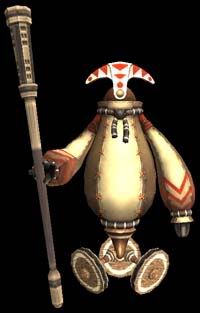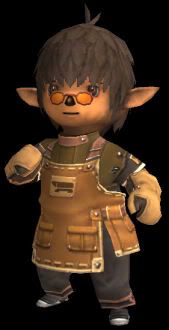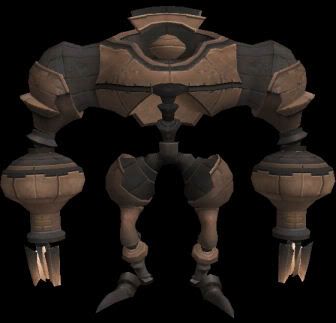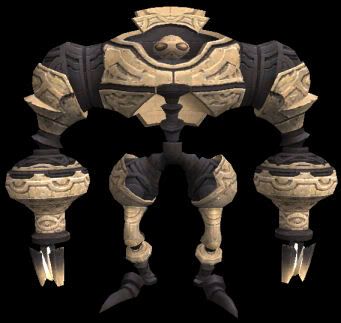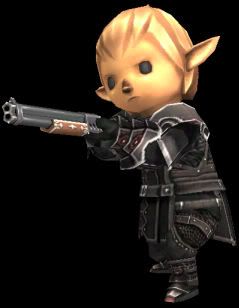Tarutaru Automatons
Tarutaru Automatons are automated robotic soldiers and manual labourers that are used by the Tarutaru nations to enhance productivity and save money. Unlike other nations they put these as active participants in almost every part of their lives save their personal services. Their artificial intelligence is relatively simply limiting them to extremely basic tasks and non-sentience. It was made illegal forever to produce any type of artificial sentience in the automatons because then they would think for themselves and potentially become dangerous. The Tarutaru don't actually have that ability or technological achivement anyways. Their best scientists estimate to create artificial sentience would take nearly two to three centuries before it can become a reality. The first types of automatons were the Cardian Guards. Named after Tarot Cards and their classes and distinctions the Cardian Guards were the longest reigning automatons in the Tarutaru civilization. Their dominance lasted nearly 2000 years and came with the Zionarens from the Xheng Empire. After the modernization programs they realized that the old Cardian Guard design would have to change. Eventually the Kratloctostan civil war proved that the old design had to be significantly changed.
The design was completely scrapped. Though the triwheel design proved useful in the past it was no longer practical. Over the skeletal frame the Tarutaru added enormous armor plating to the external arms that were now much larger and powerful to provide manual labour. To assure that they were able to move well through any terrain the triwheel design was eliminated and two feet were installed their arms were strong enough to lift vehicles. The result of the new Mark-II Cardian Guards was a huge increase in labour and construction.
The Tarutaru realized that these new powerful Mark-II Cardian Guards would have to have supervision. They lived in fear that these automatons would be turned against them and created the Mark-III Cardian Guards as overseers. The Mark-II and Mark-III models were self sufficient machines meaning they had modular components and could repair each other, eliminating the need for a field technician, but nontheless a field technician and tactical supporter had to be present to provide direct orders in battle and in construction work. The Mark-II design and Mark-III design had one huge disadvantage: they no longer could manipulate small weapons like the Cardian Mark-I design. To compliment this the Tarutaru themselves participated in combat weilding the weapons that normally the now more rare Mark-I's had used.
</div>However with all the automated troops being produced they were larger than the originals so the Mark-I had to still be produced to drive vehicles and do menial grunt work. The Tarutaru themselves were never free from the burdens of warfare as they had to coordinate the situation in every location. No doubt if a Cardian was seen, a Tarutaru was nearby. To distinguish the Mark-II Cardian to Mark-III, a simple paint job difference was used. The Mark-III Overseer Cardians could be reprogramed like all Cardians and were put in charge of small projects and coordinated simple tasks. The Tarutaru themselves preferd to use them as just eyes and ears in the battlefield.
Reprogramming a Cardian was exceptionally difficult. The Tarutaru knew that enemies would try to use these troops against their masters and created multiple computer safeguards to prevent tampering. The Cardians are made out of hardened plastics and metal which make them durable and resistant to some of nature's effects but they are by no means, perfect. The four Ace Guardians which were created to oversee the first Mark-I's still existed and were over 2000 years old and had to be dismanteled. When the Tarutaru created the newer versions they had to program the entire communications network so that the older models would accept programming from the newer ones. It was a grueling task that took years to perfect before the Kratloctostan civil war but the new Mark-II's were never used then. The older versions were pilled in stock and mass produced to fill the army. The Tarutaru in Zionaren were at first opposed to this but when the other nations started to move agressively they knew they had to make a stance to protect their people and their culture.
The use of Cardian Guards has often by seen by other nations as a "cheap shot" military that sends thousands of expendable troops into a war to swarm and overwhelm their enemies without loosing a single life themeslves but this is infact untrue. Cardian Guards require a great deal of care and management, though they do not cost as much as conventional soldiers. Grease and spare parts cost less than food and medical facilities, shelter and heat so the Zionaren Defense Forces and the Trilan Defense Forces are considerably cheaper compared to others of their size.
</div>The latest experimentations were to create a nearly fully robotic Tarutaru Soldier. Artificial intelligence had not yet reached this level but the mechanization processes had already been somewhat successful. The proposition of an articial lifeform, technological based. Over experimentation has resulted in a fully functional Drone Soldier but it was prohibitably expensive to produce in large numbers. The drone soldier was equiped with the artificial intelligence of a Mark-III Cardian Guard so it had very basic skills. Due to its small compact size it was virtually indistinguishable to other Tarutaru, The Xheng Empire government proposed to create these drones in limited numbers for espionage purposes, robotic spies to make sure their enenmies and rivals were kept in line.
</div>While they are intimidating in apperance, the Mark-1 Cardian Guards were only 5 feet tall, and their predecessor models were similar in height. They were mainly designed for labour and not combat. Only when war was happening did they become military use property.
